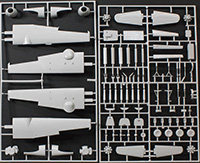
Hasegawa 1/72 P2V-7 Neptune Kit First Look
By Michael Benolkin
| Date of Review | December 2017 | Manufacturer | Hasegawa |
|---|---|---|---|
| Subject | Lockheed P2V-7 Neptune | Scale | 1/72 |
| Kit Number | 02258 | Primary Media | Styrene |
| Pros | Easy build, unique subject | Cons | See text |
| Skill Level | Basic | MSRP (USD) | $54.95 |
First Look
 |
 |
 |
 |
The Lockheed P2V Neptune started its life during World War Two to meet the requirements for a long-range maritime bomber and submarine hunter to replace two earlier Lockheed designs, the PV-1 Ventura and PV-2 Harpoon. While its predecessors were evolutions of pre-war transport designs, the Neptune was designed from the ramp-up for its mission. Full-scale development started in 1944 with a first-flight in 1945, production in 1946, and entered service with the US Navy in 1947. The design evolved over time with later variants being refitted with two jet engine pods to provide additional take-off power for higher gross weights without having to resort to RATO. The seventh major model, the P2V-7 would be built with the jet engines installed on the production line. In the early 1960s, the Pentagon dictated that the services would standardize their weapons systems designations, the P2V became the P-2 and the P2V-7 would become the P-2H.
While the Neptune never had to fire a shot in anger (officially) as an ASW aircraft in its USN cold war service, the aircraft did see combat in Vietnam as a number were modified for interdiction missions along the famous 'Ho Chi Mihn Trail'. The Argentine Navy used their Neptunes during the Falklands war until they ran out of spare parts and grounded the type. Several Neptunes in Taiwan service were shot down by the Peoples Republic of China. Even after the Neptune was retired in favor of yet another Lockheed design - the P-3 Orion, Neptunes did continue service as bombers fighting forest fires around the US.
Here is another Hasegawa classic kit. First released in 1972 (when I graduated from high school), this kit has been reissued a number of times over the years (decades) including in Minicraft boxes (while Minicraft imported the Hasegawa line into the North American market, also many moons ago) and at least one Revell/Germany boxing. It is interesting how this common sight around the globe has never been produced in injection-molded styrene by anyone other than Hasegawa in anything larger than 1/144. With the interesting variants that would also make good releases like the OP-2 sensor-dropping Neptune and the AP-2H gunship, both veterans of the Vietnam war, this subject is long overdue for some new tooling. Nevertheless, the Hasegawa tooling has held up well over the years and exhibits minimal mold flash, and Hasegawa has released a one limited edition version with special parts to replicate a special Japanese testbed variant.
The kit is molded in light gray styrene and presented on four parts trees, plus one tree of clear parts. Due to the age of the mold designs, the kit's surface detailing is raised. The kit offers the following features and options:
- Basic flight deck
- Choice of rear dorsal turret or overhead window insert
- Optional pilot, copilot, and nose observer figures
- Solid wing spar structure through the fuselage for good strength
- Positionable rudder
- Ailerons molded into wing in neutral position
- Elevators molded into horizontal stabilizers in neutral position
- Flaps molded up
- Positionable cowl flaps
- Jet engine pod front spring-loaded doors molded closed
As with many kits this old, cockpit detailing is minimal though you can do a little detailing of your own if you're so inclined. Eduard helped out with set 72364 that detailed up the cockpit and a number of exterior areas including the wheel wells. The set also includes the boarding ladder in the nosewheel well. Eduard also released set 72365 to provide for the interior of the weapons bay (non-existent in the kit as the bay doors are molded closed).
The kit includes decals for two examples:
- SP-2H, 143173, VP-30, LL/43
- SP-2H, 147963, VP-69, PJ/5
If neither of these subjects are of interest, Caracal Models recently released two decal sets for this kit to offer a total of 13 different marking options as well as color schemes.
This is a great kit and I'm glad to see it still in circulation. I'd love to see a version of this kit with the turboprop engines as flown by the JMSDF, but the combination two R3350 radial engines and two J34 jet engines makes for a powerful combination.
My sincere thanks to Hasegawa USA for this review sample!
Here is a list of paints Hasegawa identifies for the colors of this kit and the equivalent colors from other brands:
H001
N001
B125
C125
A014
36104
X02
H003
N003
B276
C276
36131
X07
H008
N008
B003
C003
36190
LP11
X11
H012
N012
B041
C041
XF01
H014
N014
B704
C704
X06
H018
N018
36191
X10
H040
N040
X21
H044
N044
XF15
H076
N076
XF84
H085
N085
H090
N090
X27
H093
N093
X23
H301
B030
C030
H315
H316
B049
C049
A062
H317
B044
C044
H318
H327
B219
C219







